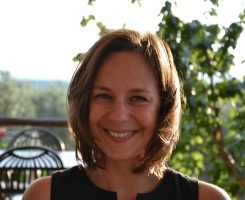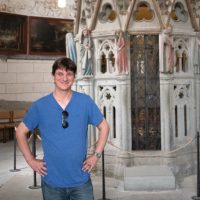CAA News Today
S. Hollis Clayson Named AC2024 Distinguished Scholar
posted by CAA — November 29, 2023
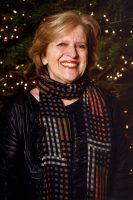
The Distinguished Scholar session at the 112th CAA Annual Conference will honor the acclaimed career of S. Hollis Clayson. Clayson has been at the forefront of art history scholarship as part of the first generation of feminist academics whose work centers on representations of the female body, the role of art in social and political conflict, and the intersection of art and technology.
Hollis Clayson is Professor Emerita of Art History and Bergen Evans Professor Emerita in the Humanities at Northwestern University where she taught for thirty-five years, advising twenty-seven doctoral dissertations. A specialist in nineteenth-century European art, she has published widely on art practice in Paris as well as transatlantic cultural exchanges, especially those between France and the United States. Her books include Painted Love: Prostitution in French Art of the Impressionist Era (Yale University Press, 1991), Paris in Despair: Art and Everyday Life Under Siege (1870–71) (University of Chicago Press, 2002), Is Paris Still the Capital of the Nineteenth Century? Essays on Art and Modernity, 1850–1900, co-edited with André Dombrowski (Routledge, 2016), and Illuminated Paris: Essays on Art and Lighting in the Belle Époque (University of Chicago Press, 2019). Her book in progress is entitled The Dark Side of the Eiffel Tower.
Clayson’s research has been supported by the American Council of Learned Societies (ACLS), the Getty Research Institute, the Clark Art Institute, Institut national d’histoire de l’art (INHA), the Huntington Library, Columbia University’s Reid Hall in Paris, and the Center for the Advanced Study of the Visual Arts (CASVA) at the National Gallery of Art. In early 2014, she was named a Chevalier in the Ordre des Palmes Académiques by the French Ministry of Culture.
From 2006–13 she served as the founding Director of the Alice Kaplan Institute for the Humanities at Northwestern. She was Sterling Clark Professor in Art History, Williams College in fall 2005; the Samuel H. Kress Professor at CASVA (2013–14; and in fall 2015, she was Kirk Varnedoe Visiting Professor at the Institute of Fine Arts, New York University. Most recently, she was the 2022–23 R. Stanton Avery Distinguished Fellow at the Huntington Library.
Dr. Clayson’s career and her impact on the field will be celebrated with presentations and a dialogue with scholars and colleagues:
Session Chairs:
Anne Helmreich, Smithsonian Archives of American Art
Hector Reyes, University of Southern California
Session Panelists:
Thomas Crow, New York University
André Dombrowski, University of Pennsylvania
Marc Gotlieb, Williams College
Martha Ward, University of Chicago
The AC2024 Distinguished Scholar Session will be held on Thursday, February 15, 4:30–6:30 p.m. CT at the Hilton Chicago. This event will also be livestreamed on YouTube.
Register now for the CAA 112th Annual Conference, February 14–17, 2024 in Chicago!
Meet the 2024 CAA-Getty International Program Participants
posted by CAA — November 29, 2023
CAA is pleased to announce this year’s participants in the CAA-Getty International Program. Now in its thirteenth year, this international program, supported by the Getty Foundation, welcomes twelve new participants and four alumni to attend the 2024 Annual Conference in Chicago, IL. The goal of the CAA-Getty International Program is to increase international participation in CAA’s activities and the field of visual arts in academia, thereby expanding international networks and the exchange of ideas both during and after the conference. We look forward to welcoming this year’s participants!
At a preconference colloquium, the new participants will discuss key issues in the international study of art history together with CAA-Getty alumni and US hosts. The program will delve into topics such as postcolonial and Eurocentric legacies, decolonization of museums, scholarship and pedagogy, interdisciplinary and transnational methodologies, and the intersection of politics and art history. Learn more about the first ten years of the program in our online publication.
Program participants—art historians, curators, and artists—hail from multiple countries, expanding CAA’s international membership and contributing to an increasingly diverse community of scholars and ideas. Selected by a jury of CAA members from a highly competitive group of applicants, each participant will receive funding for travel, hotel accommodation, conference registration, CAA membership, and a per diem.
Alumni invited back to the 2024 conference will present at the Art, Authenticity, Migration, and Global Climate Change session while also connecting our new participants to our burgeoning group of nearly 160 CAA-Getty International Program alumni.
2024 PARTICIPANTS IN THE CAA-GETTY INTERNATIONAL PROGRAM

Mariela Cantú is a researcher, audiovisual preservationist, artist, and curator. She is a PhD candidate in Art History at the University of San Martín (CIAP-UNSAM CONICET) and holds a master’s degree in Preservation and Presentation of the Moving Image (University of Amsterdam). She is a member of RAPA—Argentinian Network of Audiovisual Preservationists, and the creator of Arca VIDEO, a collaborative archive of Argentinian video art. She has undergone specific training on video preservation at Associação Cultural Videobrasil (Brazil), La Camera Ottica (Italy), Media Burn Archive and Video Data Bank (USA), and Cinemateca Boliviana (Bolivia), while also attending the Film Preservation and Restoration School Latin America (CINAIN, Cineteca de Bologna, L’Immagine Ritrovatta and FIAF). She has been a professor at Universidad de Buenos Aires, Universidad del Cine, Universidad Nacional del Arte, and Universidad Nacional de La Plata, among others.
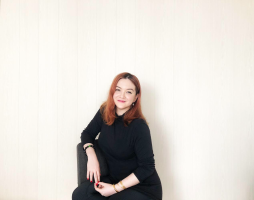
Kathleen Ditzig is a curator at National Gallery Singapore. She received a PhD from Nanyang Technological University in 2023 with a dissertation titled “Exhibiting Southeast Asia in the Cultural Cold War: Geopolitics of Regional Art Exhibitions (1940s–1980s).” She obtained an MA from the Center for Curatorial Studies, Bard College, in 2015. Inspired by her experience in cultural policy, Ditzig studies modern and contemporary Southeast Asian art in relation to global histories of capitalism, technology, and international relations. As a curator and researcher, she is invested in advancing and interrogating art as an exceptional site and system of speaking to power. She won an IMPART Curatorial Award in 2021. Her writing has been published by Southeast of Now, Journal of Social Issues in Southeast Asia, Afterall, post: notes on art in a global context, Art Agenda, and Artforum, among others.

Marzouka Hanna Ibrahim Gaied has a bachelor’s degree in Egyptology from El Minya University, Egypt. Their research has focused primarily on the art of Middle Kingdom (about 2000 BCE) in the Beni Hasan al-Shuruq area of Middle Egypt, and they have wide-ranging experience working on many archaeological sites across Egypt. In their current position as Inspector of Antiquities at the Central Department for Seized Antiquities, they are on the front lines of addressing the trade in looted artifacts, which drains Egypt of its cultural resources. Their experiences have provided them with a deep knowledge of excavation techniques, collection management, and a passion for local community engagement.

Paweł Ignaczak graduated in art history at the Adam Mickiewicz University in Poznań, where he earned a PhD for his thesis on etchings of Jean Pierre Norblin de la Gourdaine (1745–1830) in 2013. Between 2003–15 he worked in the Print Room of the National Museum in Poznań and in the print collection of the Polish Library in Paris. From 2015–22 he worked at the Museum of Warsaw. Since 2015, he has been lecturing at the Academy of Fine Arts in Warsaw, and since 2020 he has been vice-dean at the Faculty of Artistic Research and Curatorial Studies. Currently, he’s been conducting research on amateur artistic work in Poland in the second half of the eighteenth and early nineteenth centuries.

Eyitayo Tolulope Ijisakin is an associate professor in the Department of Fine and Applied Arts, Obafemi Awolowo University, Ile-Ife, Nigeria. His doctoral research focuses on printmaking and the developmental history and contributions of printmaking to contemporary Nigerian art. He has written for Critical Arts and African Arts. Dr Ijisakin is a Fellow of the American Council of Learned Society in the African Humanities Program. He was a Postdoctoral Fellow with the Arts of Africa and the Global South, Rhodes University, South Africa (2017–18). He also received the Carnegie Corporation of New York Fellowship for the 63rd Annual Meeting of the African Studies Association (2020). He has served as a reviewer for several international journals. He is listed among the artists whose works engage social change by the Denver Art Museum, in 2022. He is a member of the Society of Nigerian Artists and the Nigerian Field Society.
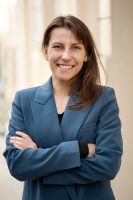
Agnieszka Patala is an assistant professor in the Institute of Art History, University of Wroclaw. The area of her academic focus is medieval art in Europe, with particular reference to panel painting and sculpture—the (multisensorial) relations of artworks with the viewer and space, their use in devotional practices, extra-religious realities of their functioning, including afterlives in the nineteenth totwenty-first centuries. In 2015 she wrote her dissertation on the impact of Nuremberg art and artists on late Gothic panel painting in Silesia. It was published in 2018 and served as a foundation for exhibition, Migrations: Late Gothic Art in Silesia (National Museum in Wroclaw). Currently, she is at work on her postdoctoral project determining the origins, functions, and agency of early altarpieces in Central Europe. She is also a co-investigator in the project, Residua of Premodern Relations with Art in Selected Contemporary Convents in Poland.
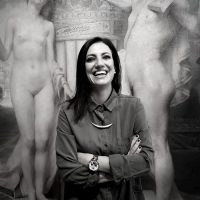
Elena Stylianou researches, writes, and curates at the intersection of the history and theory of photography, modern and contemporary art, critical studies, and museum and curatorial practices. She is currently associate professor at European University Cyprus and president of the International Association of Photography and Theory (IAPT). Her scholarship has been published in peer-reviewed journals and edited volumes, and she is co-editor of Museums and Photography: The Display of Death (Routledge, 2018), Ar(t)chaeology: Intersections of Photography and Archaeology (IAPT Press, 2019), and Contemporary Art in Cyprus: Politics, Identity and Culture Across Borders (Bloomsbury, Spring 2021). She is currently working on a special issue on processes of decolonization and the photographic archive. Elena earned her doctoral degree from Columbia University Teachers College, is a recipient of numerous awards and grants, including a Fulbright and an ArtTable fellowship, and she held a postdoctoral position at UCL, London. She has curated international art exhibitions in Cyprus, and is the lead researcher of several funded projects dealing with arts and heritage.
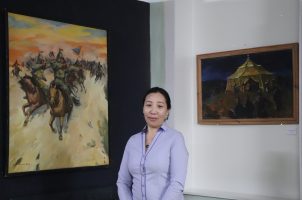
Suvdaa Sampil is a curator at the History and Local Museum of Tuv province, Mongolia, and has been working as a museum curator since 2011. They have written academic articles on cultural heritage research, art history, and interethnic relations that have been published in national and international journals. Moreover, they wrote the books Cultural Heritage of the Central Region and The Settlement of Ethnic Groups in the Tuv Province: Some Cultures and Traditions. After receiving a master’s from the University of Mongolia in 2007, their research concentrated mainly on Mongolian and local cultural heritage and art history. Sampil is in charge of the cultural heritage and collections at the museum and curates permanent temporary exhibitions. In 2016, they were a member of the International Committee for Museums and Collections of Modern Art (CIMAM), an Affiliated Organization of ICOM, and became a member of the International Committee of Museums (ICOM) in 2018.
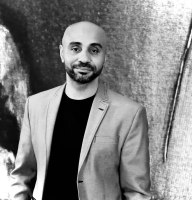
Igor Simões has a PhD in Visual Arts—History, Theory, and Criticism of Art at the Programa de Pós-Graduação em Artes Visuais da Universidade Federal do Rio Grande do Sul (PPGAV-UFRGS) and is the adjunct professor of History, Theory, and Criticism of Art and Methodology and Practice of Art Teaching (UERGS). He was assistant curator of the 12th Mercosur Biennial, member of the curatorial committee of the National Association of Fine Arts Researchers (ANPAP). He works with the links between exhibitions, film editing, art history, and racialization in Brazilian art and the visibility of Black subjects in the visual arts and is the author of the thesis “Film Editing and Exhibition: Black Voices in the White Cube of Brazilian Art.” He is also a member of the curatorial committee of the Museum of Contemporary Art at the University of São Paulo/USP. Curator of the exhibition “Presença Negra no Museu de Arte do Rio Grande do Sul” (2022). He is a member of the curatorial boards of the exhibitions Social Fabric and Enpowerment and a member of the board of AWARE—Archives of Women Artists, Research and Exhibitions and Fractured Times. In 2023 he was general curator of Dos Brasis: Arte e pensamento negro, the most comprehensive exhibition of Black Brazilian artists (Brazil- São Paulo). That same year he was guest curator at the Inhotim Institute for the 2023 season, curating the exhibitions Mestre Didi: The Initiates in Mystery Don’t Die and Doing the Modern, Building the Contemporary: Rubem Valentim and the Right to Form. In 2024, he will co-curate Rosana Paulino: Atlântica e Amefricana at Museo de Arte Latinoamericano de Buenos Aires (MALBA).
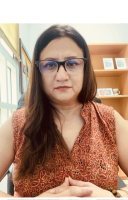
Trained as a studio artist with a major in sculpture, Kanwal Syed earned her PhD in art history from Concordia University as the 2023 Graduate Valedictorian. During her candidacy, she earned the prestigious FQRSC doctoral grant and numerous internal grants, published three journal articles, co-chaired two panels at the annual College Art Association conference, and presented papers at academic conferences in Vancouver, Brighton, Rome, and Chicago. Her dissertation titled “ھم گنہاگار عورتیں (We Sinful Women): Urban Feminist Visuality in Contemporary Art and Feminist Movements in Pakistan After 9/11,” garnered an Honorable Mention in the UC Berkeley South Asia Art & Architecture Dissertation Prize 2023 and has been nominated for NAGS Dissertation Award 2023–24. Before joining American University in Dubai as an Assistant Professor of Art history, she worked as an adjunct faculty at the University of British Columbia and as a part-time faculty at Concordia University. Her research interests encompass non-Western art, decoloniality and cultural feminist visuality in contemporary art.
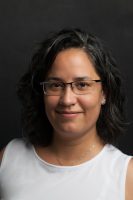
Carolina Vanegas Carrasco researches the processes of creation and reception of nineteenth-century monuments in Latin America. She is the current director of Centro de Estudios Espigas at the Universidad Nacional de San Martín, Argentina, and researcher of the Centro de Investigaciones en Arte y Patrimonio (CONICET-UNSAM). Vanegas is General Coordinator of the Group of Public Art Studies in Latin America based on the Universidad de Buenos Aires. She is the author of Disputas monumentales: escultura y política en el Centenario de la Independencia en Colombia (Bogotá, 1910) (2019, Instituto Distrital de Patrimonio Cultural of Bogotá).
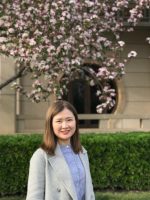
Fanying Zhang, an Assistant Professor in the Department of Arts Administration, Education, and Policy at the China Academy of Art, earned her Ph.D. in Art History in 2021. Her research focuses on unraveling how the Western world shaped its perceptions of Chinese art in the 20th century. She places particular emphasis on analyzing exhibitions, conferences, publications, and the contributions of scholars, artists, and curators to the global dissemination of Chinese art. Zhang’s academic career commenced with a graduate program centered on Osvald Sirén who had already been an accomplished scholar in the study of Trecento painting before getting involved in the study of Chinese art. After that, she expanded her interests in transcultural art history, particularly the role of Chinese art in constructing global art history. She has incorporated this interest into her teaching and is engaged in international collaborations. She is also involved in a project on Professor James Cahill’s archive initiated by the China Academy of Art, further enriching her experience in the field.
PARTICIPATING ALUMNI
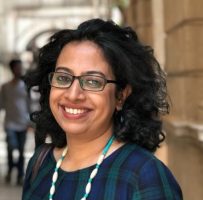
Amrita Gupta is an art historian, writer, administrator, and editor involved in arts education and cultural management. With over two decades in the nonprofit cultural sector in India, she has contributed through art historical research, teaching, published writing, arts programming, and institution building. In 2002, she joined the Mohile Parikh Center (MPC), Mumbai, and became its Program Director in 2005, a responsibility she served till early 2023. In this capacity, she facilitated critical thinking by curating a wide range of innovative art education programs, initiating public art projects, and co-creating short art videos for diverse audiences, and remains associated with the MPC in an honorary capacity. She is Founding Member and Co-director at the Council for Arts and Social Practice (CASP), established in 2013 as a transdisciplinary platform to facilitate critical dialogues on cultural sustainability. Her practice at CASP focuses on the interplay of social history, fieldwork, community-based art, and collective experience. She serves as a jury member for the Arthur Kingsley Porter Prize for Art Bulletin articles and the SAIL Mentorship Program (Edition III) at Sunaparanta Goa Center for the Arts. In 2019, she co-founded and edits the e-journal, Partition Studies Quarterly (PSQ), which focuses on partition narratives of Northeast India, and other less-remembered partition stories in the subcontinent. Her ongoing and independent research focuses on the art practices of Northeast India, and an essay on this topic has been published in the edited book 20th Century Indian Art (Thames & Hudson and Art Alive, 2022). Her art writings for anthologies, journals, exhibition catalogs, and magazines have been published widely in leading print and digital platforms; she has edited art books for children and continues to write on Indian modern and contemporary art.
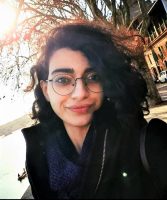
Delaram Hosseinioun received her first MA in literary criticism from the University of Exeter and her second MA in cultural studies from KU Leuven University. In her PhD project at Utrecht University, titled “Unveiling the Other: The Metamorphosis of Voices of Iranian Female Artists from the Mid-Twentieth Century to the Present Day,” Delaram draws from gender theories in poststructuralist psychoanalysis, such as in the works of Butler and Cixous, along with theories regarding self and forms of othering in continental philosophy, namely works of Bakhtin and Derrida. Her goal is to trace the trajectories and endeavors of Iranian female artists in reclaiming their identities. Working along with the artists Delaram explores the artworks as a pictorial form of dialogue and artists’ attempts in surpassing sociocultural restraints. Delaram’s focus rests on the revelation and universality of women’s voices in creative platforms, art journalism and interviewing artists beyond borders.
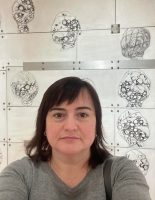
Mariana Levytska is an associate professor in the Department of Graphic Design and Artbooks of the Ukraine Academy of Printing. She works as a part-time senior research associate in the Department of Art Studies of the Ethnology Institute at the national Academy of Ukraine in Lviv. She received her PhD in the history of art from the Lviv National Academy of Arts in 2023. She specializes in Ukrainian art of the long nineteenth century through social art history optics. In 2022 she began a research project focused on artists’ response to the warfare in Ukraine, after the full-scale Russian invasion.
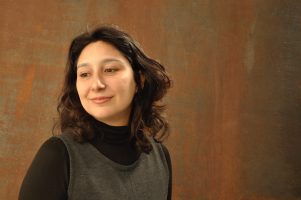
Ana Mannarino is an art historian and professor of Art History at School of Fine Arts at Federal University of Rio de Janeiro (EBA-UFRJ) and at Visual Arts Postgraduate Program at Federal University of Rio de Janeiro (PPGAV-UFRJ). She received her PhD in Art History/Visual Arts at PPGAV-UFRJ and participated in a yearlong collaborative study program at Université Sorbonne Nouvelle-Paris 3. Her doctoral thesis, “Word in Brazilian Art: Mira Schendel and Waltercio Caldas,” focuses on the relationship between text and image in Brazilian contemporary art, especially in the work of these two artists. Her research also considers modern art and historiography of art in Brazil, the connections between art and poetry, Concrete art, and the production of artists’ books.
This program is made possible with support from Getty through its Connecting Art Histories initiative.

Meet the 2024 CAA Annual Conference Kress Travel Grant Recipients
posted by CAA — November 28, 2023
Recognizing the value of the exchange of ideas and experience among art historians, the Kress Foundation is offering support for scholars participating as speakers at the 2024 CAA Annual Conference. The scholarly focus of the papers must be European art before 1830.
Samuel H. Kress Foundation CAA Annual Conference Travel Fellows 2024

Michela Degortes, Researcher, University of Lisbon
“Approaching the Portrait Gallery of the Academy of Sciences of Lisbon”
Art Collections of Academies of Sciences
Chair: Viktor Oliver Lorincz
The Academy of Sciences of Lisbon was founded in 1779 under the patronage of Maria I of Braganza, thanks to the effort of enlightened figures of the Portuguese aristocracy, clergy, and scientific elite. A print published the same year in the Jornal Enciclopedico to celebrate the event represents the queen surrounded by a circle of learned courtesans while holding hands with a figure symbolizing Knowledge. A portrait of Maria I located in one of the main rooms of the Academy celebrates her role as a patron.
Painted by the Irish artist Thomas Hickey in 1783, it is part of the gallery of paintings held by the Academy of Sciences of Lisbon, which brings together the portraits of remarkable figures of the eighteenth- and nineteenth-century Portuguese cultural milieu. It includes portraits of other members of the royal family as well as of important members of the institute, such as José Francisco Correia da Serra, Manuel de Cenaculo, and Joseph Mayne, whose cabinet of curiosities constitutes the museum of the Academy. Despite the remarkable quality of many of these artworks and their influence on the Portuguese artistic context, the collection still lacks a deep investigation. This paper focuses on the sitters, the artists involved, and the donations that formed the collection, and gives rise to interesting comparisons to similar art collections held by other academies of science.
Charline Fournier-Petit, PhD candidate, University of Maryland and Lecturer, École du Louvre
“Elisa Bonaparte Baciocchi and Diplomacy: A Gift of Fourteen Portraits,”
Women and Diplomatic Art
Chair: Silvia Tita
Tense, if ever conflicting, were the relationships between Elisa Bonaparte Baciocchi, Grand Duchess of Tuscany, and her brother, the emperor Napoleon I. A clever ruler, she rapidly exploited the marble quarries of Carrara for diplomatic purposes, producing abundant portraits of the great sovereigns of her time. Sculpture also served her as a surrogate for diplomatic dialogue with the emperor to affirm her legitimacy as the sovereign of Tuscany and her daughter’s dynastic succession. In 1809, Elisa Bonaparte Baciocchi gifted a series of fourteen marble portraits depicting members of the Bonaparte family to Napoleon I, including her own bust and that of her daughter, Napoléone-Elisa. Extracted from her own quarries and intended for the busy Galerie de Diane at the Palais des Tuileries, this series in marble was both a political message sent not only to the childless emperor, but also to their siblings and to the court. With this gift, Elisa Bonaparte Baciocchi demonstrated her capability to impose her authority over a conquered province and restore the prestige of Carrara. And, by gathering quickly such a large number of sculptures, she was also displaying the production capacity of her marble quarries. The gift also epitomized her diplomatic strategy and dynastic aspiration, thorugh which Elisa Bonaparte Baciocchi turned her motherhood into a powerful argument supporting her political ambitions.
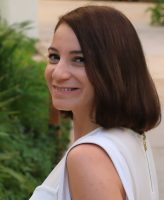
Gohar Grigoryan, , University of Fribourg, Switzerland
“An Illustrated Armenian Law Book and the Ceremonial Mise-en-scène of the King’s Body”
Medieval Ritual Representations: Model of or Model for?
Chairs: Alice Isabella Sullivan and Robert Nelson
A miniature created in 1331 in the Cilician Armenian capital of Sis depicts the young king Lewon IV (r. 1321–1341) at the tense moment of executing—according to the nearby inscription— “just judgment.” The full-page image serves as frontispiece to the oldest extant copy of the Assizes of Antioch—a now-lost Frankish legal code. An important monument of secular law, the Assizes of Antioch was influential beyond the Principality of Antioch and the crusader states, reaching the Armenian Kingdom of Cilicia (1198–1375). Its main purpose was the regulation of the relationship between the suzerain and his vassal lords, and it is exactly these relationships that are represented in the miniature in question, with the king seated on an elevated throne and executing justice over his lords. Initiated by the king himself, the juridical image of Lewon IV was heavily charged with realistic codes, idealizing symbols, and eschatological messages, the intended meanings of which will be tackled in my paper. I will first focus on how the king’s painter, Sargis Pitsak, visualized the ceremonial mise-en-scène around the sovereign’s imposing body and how the latter’s political agenda is reflected in this and other portrayals of him. The discussion continues with questions of visibility and the particular occasions at which the target audience could possibly see an emblematized image like this.

Laura Hutchingame, PhD candidate, University of California Los Angeles
“Red Larch at San Fermo: Ligneous Knowledge in the Upper Adriatic”
Wood: Medium Specificity in the Global Early Modern Period
Chair: Tatiana String
In the late medieval Adriatic, wood was a crucial natural resource and building material that required highly specialized knowledge. From felling alpine trees, preparing logs into rafts, floating rafts downriver, to storing and seasoning timbers, the preparation of lumber involved labor-intensive processes. The “ship-hull ceiling,” in the form of an inverted ship, was an important artifact that proliferated throughout the region from ca. 1300–1450 and was fostered by the collaboration between different wood-based artisans. The ceiling at the church of San Fermo in Verona, executed from ca. 1300–50, offers an exceptional case study. In addition to its innovative design, recent conservation work has uncovered material evidence of how artisans sourced appropriate lumber, prepared timbers, and crafted the ceiling from local red larch. I highlight the specialized ligneous knowledge of artisans who contributed to the production of the ceiling. I show how the ceiling (and wood itself) is a source of interconnections between patrons, artisans, political regimes, and religious orders of this time. At San Fermo, the material and physical qualities of wood are neither representational nor represented but are made visible through crafting.
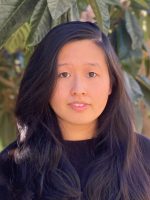
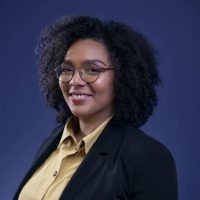
Cynthia Kok, PhD candidate, Yale University, and Stephanie Archangel, Curator, Rijkmuseum
“Edvardt Abraham Akaboa de Moor, a Master Silversmith from Angola”
Center and Periphery?: Mapping a Future for Research in Netherlandish Art
Historians of Netherlandish Art
Chair: Stephanie Dickey
With origins as a “prestige project,” the Rijksmuseum grapples with the legacy of prioritizing upper-class artworks and narratives, leading to criticisms that the institution is a place of and for elites. Decorative arts within the collection, however, were rarely made by the upper classes. We turn to objects and archives to consider these marginalized makers more closely. We take as a case study a gun by Edvardt Abraham Akaboa de Moor. From archival research, we learn that de Moor was a Black man from Angola who likely found his way to the Netherlands via modern-day Ghana. By 1665, however, de Moor worked as a skilled weapons engraver as a member of the silversmith’s guild and lived with his Dutch wife and children in Utrecht. The Rijksmuseum’s flintlock hunting gun is signed “Edvardt Abraham de Moor” and “tot Utrecht,” claiming ownership of the lock, the most technically difficult part of the gun. As with other marginalized figures, little information remains of de Moor—certainly no portraits nor personal archives—yet traces of him and his descendants remain in the state archives and in museums. We ask, How do we recover the identity of individuals who operated and worked in craft workshops? Can a shift in focus to makers and archives allow museums to interrogate the narratives of marginalized peoples? And how can museums conscientiously address the question, to whom does the agency of craftsmanship belong?
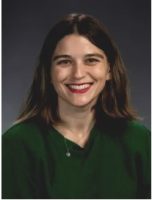 Caroline Delia Koncz, Assistant Professor, Angelo State University
Caroline Delia Koncz, Assistant Professor, Angelo State University
“Lavinia Fontana’s Minerva Unarmed: The Female Nude, as Seen and Painted by Woman”
What Did Women See? Gender and Viewing Experience in Early Modern Italy
Chair: Sabrina De Turk
Created shortly before the artist’s death in 1614, Lavinia Fontana painted a rather curious rendering of the virginal goddess of wisdom for Cardinal Scipione Borghese. Standing in profile, her head tilted speculatively towards the viewer, Minerva holds in her arms a sumptuous dress of luxurious fabrics and gold trim, which she is presumably about to don. Beside her in the room, one can find the deity’s pet owl alongside her previously adorned armor, helmet, and shield, all of which serve to identify the goddess. Such objects were likely necessary to include, since, beyond the subject of the Judgment of Paris, remarkably few Italian artists in the early modern period depicted Minerva unrobed, and even fewer were women. I consider the unique iconography of Fontana’s painting as well as the intended message this work held for its viewers in seventeenth-century Italy. In addition to considering the male owner’s reception of the piece, this talk will more closely study how female beholders of the period might have analyzed the nude Minerva, when fashioned by the hand of a woman painter.
Matthew Sova, PhD candidate, Johns Hopkins University
“Representations of Performance in the Konstanz Holy Sepulcher”
Medieval Ritual Representations: Model of or Model for?
Chairs: Alice Isabella Sullivan and Robert Nelson
Located in Konstanz Cathedral, a thirteenth-century holy sepulcher stands as significant material evidence for widespread medieval practices of architectural copying. Understood as a reconstruction of the Tomb of Christ aedicule in the Church of the Holy Sepulcher in Jerusalem, scholars emphasize the Konstanz holy sepulcher’s reliance on the plans, dimensions, spaces, and structures of its illustrious model. These interpretations often downplay variations in appearance and function between the two microarchitectural objects, as well as regional contexts for these deviations in the Konstanz copy. Specifically, the Konstanz holy sepulcher features an extensive sculptural program of figures from Christmas, Easter, and the early church, which has no precedent in the Jerusalem aedicule. My paper investigates these sculptures, linking them to a local tradition of religious performances undertaken in and around the Konstanz holy sepulcher. Numerous medieval texts from Konstanz describe ritualized Holy Week reenactments in the city’s cathedral, performed by the clergy outside of the Mass. These paraliturgical events emphasized the roles of the three Marys, apostles, and angels, central figures in the Konstanz object’s artistic program. I show that these sculptures not only visualized the scriptural events of Easter, but served as permanent, idealized representations of Holy Week performances. Consequently, I argue that the Konstanz holy sepulcher’s sculptural program both enhanced the function of the copy as a stage for paraliturgical drama, and perpetually reinscribed historical and spiritual connections between its associated medieval community and the site of Christ’s death and resurrection in Jerusalem.
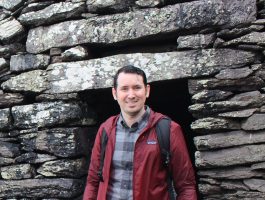 Mark H. Summers, Lecturer, University of Arkansas, Fayetteville
Mark H. Summers, Lecturer, University of Arkansas, Fayetteville
“Ritual Practice as Community Building in the Birds Head Haggadah”
Medieval Ritual Representations: Model of or Model for?
Chairs: Alice Isabella Sullivan and Robert Nelson
The Birds Head Haggadah, dated to around 1300 and produced in the Upper Rhine region of Southern Germany, is one of the earliest extant illuminated Ashkenazic haggadot, or manuscripts, that contain the ritualistic text recited at the Passover Seder. The book is well-known for its unusual approach toward figuration, styling Jewish people as hybrids with human bodies and heads of griffins, featuring the curving beaks of eagles and the pointed ears of lions. Throughout the manuscript, figurative illuminations in this style occupy the margins, enacting the historical events remembered at Passover and performing ritualistic activities associated with celebration of the feast. A pair of openings from the manuscript exemplifies this twofold approach. On folios 24v-25r, a scene from the Exodus unfolds across the lower margins. Though the story here refers to historical events of persecution, the figures that receive loaves of unrisen bread and turn to follow Moses appear in medieval styles of dress. While the story relates the flight from Egypt and pursuit by Egyptian soldiers, here the aggressors are likewise rendered as contemporary figures. As non-Jews, Pharoah and his soldiers appear as fully human figures with blank faces and are outfitted as German knights bearing the black eagle flag of the Holy Roman Empire. On the next opening spanning folios 25v-26r, the marginal program presents a scene of the ritualistic practice of making unleavened matzo, an act of abstinence that makes the historical suffering of the Jewish people tangible for the duration of Passover. The figures animating this scene, which is presented as a contemporary activity rather than a historical narrative, appear visually indistinct from the actors rendered in the previous opening. Here, the Jewish men and women working together to prepare dough, divide portions, and bake bread are all dressed in the same kinds of clothing as the followers of Moses, complete with modest hair coverings for women and the pointed hats worn by adult men that were at times compulsory accessories for men in northern medieval Europe. The approach in the visual program outlined in these openings creates a temporal elision connecting historical events with contemporary ritualistic practices. The result establishes the Passover Seder as what Marc Epstein calls a “metahistorical topos,” or a kind of temporal interconnectivity that links past, present, and future events and practices for the book’s users/viewers. I consider how the representation of ritual in the Birds Head Haggadah engages with metahistorical narratives to build community and identity for its medieval users.
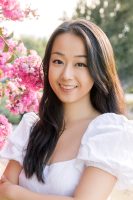 Joyce Zhou, PhD candidate and Teaching Fellow, Yale University
Joyce Zhou, PhD candidate and Teaching Fellow, Yale University
“Playing with Porcelain: Reimagining the Self with the Early Modern Dutch Dollhouse”
Miniature Designs and Worldly Simulations: Questions of Scale in Early Modern Arts
Chair: Wenjie Su
Sometime between 1743 and 1751, a Dutch woman named Sara Rothé assembled two elaborate dollhouses. Rothé describes a porcelain display room in one of her dollhouses, which survives today in the Kunstmuseum in The Hague. The room contains a variety of miniature arts, including miniature porcelain imported by the Dutch East India Company from China and Japan, as well as domestic imitations in ivory and glass. Pioneered by Amalia van Solms, Princess of Orange (1602–1675), this practice of dedicating entire rooms to the collection and display of East Asian porcelain was associated exclusively with female members of the House of Orange. While Rothé did not have the status nor financial means to recreate van Solms’ porcelain display in full-scale, she was able to successfully do so in the intimate realm of her dollhouse.
I explore the intersection of two early modern Dutch female collecting practices: the curation of dollhouses by wealthy Dutch women, and the formation of dedicated porcelain display chambers in Dutch royal circles. Building on the work of Hanneke Grootenboer and Susan Stewart, I argue that early modern Dutch dollhouses facilitated aspirational and imaginative thinking. Rothé’s porcelain room, which encapsulates Dutch royal porcelain chambers on a reduced scale, was a controlled and manipulable space in which Rothé adopted an alternate subjectivity and engaged in imaginative play. Here, Rothé could take on the persona of a Dutch royal, handling the various fruits of global commercial exchange as she engaged in immersive self-fashioning.
Wyeth Foundation Publication Grants for 2023
posted by CAA — November 17, 2023
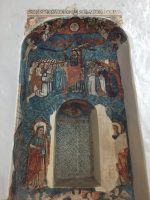
A photograph of a Maya Christian Mural of Yucatán. Credit: Amara Solari. All Rights Reserved.
Since 2005, the Wyeth Foundation for American Art has supported the publication of books on American art through the Wyeth Foundation for American Art Publication Grant, administered by CAA. The 2023 grantees are:
- Ellen Levy, A Book About Ray, MIT Press
- Ellen Macfarlane, Politics Unseen: Group F.64, Photography, and the Problem of Purity, University of California Press
- Yxta Maya Murray, We Make Each Other Beautiful: Art, Activism, and the Law, Cornell University Press
- Akela Reason, Politics and Memory: Civil War Monuments in Gilded Age New York, Yale University Press
- Amara Solari and Linda K. Williams, Maya Christian Murals in Early Modern Yucatán, University of Texas Press
Read a list of all recipients of the Wyeth Foundation for American Art Publication Grant from 2005 to the present.
BACKGROUND
For the Wyeth Foundation for American Art Publication Grant, “American art” is defined as art created in the United States, Canada, and Mexico. Eligible for the grant are book-length scholarly manuscripts in the history of American art, visual studies, and related subjects that have been accepted by a publisher on their merits but cannot be published in the most desirable form without a subsidy. The deadline for the receipt of applications is September 15 of each year.
Guidelines
Process, Materials, and Checklist
CONTACT
Questions? Please contact Cali Buckley, Manager of Grants and Awards, at cbuckley@collegeart.org.
Finalists for the 2024 Morey and Barr Awards
posted by CAA — November 16, 2023
CAA is pleased to announce the 2024 finalists for the Charles Rufus Morey Book Award and the two Alfred H. Barr Jr. Awards. The winners of the three prizes, along with the recipients of other Awards for Distinction, will be announced in January 2024 and presented during Convocation in conjunction with CAA’s 112th Annual Conference, February 14–17, 2024.
CHARLES RUFUS MOREY BOOK AWARD SHORTLIST, 2024
Delia Cosentino and Adriana Zavala, Resurrecting Tenochtitlan: Imagining the Aztec Capital in Modern Mexico City, University of Texas Press
Matthew Francis Rarey, Insignificant Things: Amulets and the Art of Survival in the Early Black Atlantic, Duke University Press
Tatiana Reinoza, Reclaiming the Americas: Latinx Art and the Politics of Territory, University of Texas Press
Andrew M. Shanken, The Everyday Life of Memorials, Zone Books
Jennifer Van Horn, Portraits of Resistance: Activating Art during Slavery, Yale University Press
ALFRED H. BARR JR. AWARD SHORTLIST, 2024
Emily Braun and Elizabeth Cowling, eds., Cubism and the Trompe l’Oeil Tradition, The Metropolitan Museum of Art
James A. Doyle, Oswaldo Chinchilla Mazariegos, and Joanne Pillsbury, eds., Lives of the Gods: Divinity in Maya Art, The Metropolitan Museum of Art
Diana Seave Greenwald, ed., Betye Saar: Heart of a Wanderer, Princeton University Press and the Isabella Stewart Gardner Museum
Leo G. Mazow, Storied Strings: The Guitar in American Art, Virginia Museum of Fine Arts
David Pullins, and Vanessa K. Valdés, eds., Juan de Pareja: Afro-Hispanic Painter in the Age of Velázquez, The Metropolitan Museum of Art
ALFRED H. BARR JR. AWARD FOR SMALLER MUSEUMS, LIBRARIES, COLLECTIONS, AND EXHIBITIONS SHORTLIST, 2024
Christophe Cherix, Courtney J. Martin, Akili Tommasino, and Stephanie Weissberg, Barbara Chase-Riboud Monumentale: The Bronzes, Princeton University Press, Princeton, and the Pulitzer Arts Foundation
Elliot Bostwick Davis, Edward Hopper & Cape Ann: Illuminating an American Landscape, Rizzoli Electa, New York, and The Cape Ann Museum, Boston
Apsara DiQuinzio, Jeff Gunderson, Alexander Nemerov, and Elaine Y. Yau, Adaline Kent: The Click of Authenticity, Rizzoli Electa New York and the Nevada Museum of Art, Reno
Perrin Lathrop, ed., African Modernism in America, Yale University Press, New Haven, and the American Federation of Arts
Apply for Student Travel to Special Exhibitions
posted by CAA — November 07, 2023
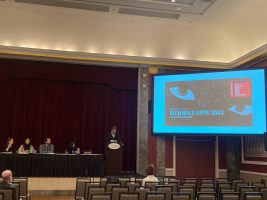
Christopher Heuer and students from the course Pilgrimage/Exhibition/Biennale discussing their experience at the Venice Biennale during the CAA Annual Conference 2023 in New York, NY.
In fall 2018, we announced CAA had received an anonymous gift of $1 million to fund travel for art history faculty and their students to special exhibitions related to their classwork. The generous gift established the Art History Fund for Travel to Special Exhibitions. We are happy to accept new applications again for this upcoming year.
The fund is designed to award up to $10,000 to qualifying undergraduate and graduate art history classes to cover students’ and instructors’ costs (travel, accommodations, and admissions fees) associated with attending museum special exhibitions throughout the United States and worldwide. The purpose of the grants is to enhance students’ first-hand knowledge of original works of art. Interested members can also see recent awardees share their experiences at the session at the CAA Annual Conference.
Applications are due by January 15, 2024.
Shelly C. Lowe, Chair of the National Endowment for the Humanities, to give CAA AC2024 Convocation Keynote Address
posted by CAA — November 07, 2023
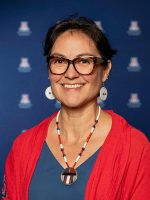
CAA is delighted to announce Shelly C. Lowe, Chair of the National Endowment for the Humanities, as the 2024 Convocation keynote speaker during the organization’s 112th Annual Conference in Chicago.
Chair Lowe is a citizen of the Navajo Nation and grew up on the Navajo Reservation in Ganado, Arizona. From 2015 to 2022 she served as a member of the National Council on the Humanities, the twenty-six-member advisory body to NEH, an appointment she received from President Obama. Lowe’s career in higher education has included roles as Executive Director of the Harvard University Native American Program, Assistant Dean in the Yale College Dean’s Office, and Director of the Native American Cultural Center at Yale University. Prior to these positions, she spent six years as the Graduate Education Program Facilitator for the American Indian Studies Programs at the University of Arizona.
Lowe has served in a variety of leadership roles nationally, most recently as a member of the University of Arizona Alumni Association Governing Board and of the Challenge Leadership Group for the MIT Solve Indigenous Communities Fellowship. She has served on the board of the National Indian Education Association and as a trustee on the board for the National Museum of the American Indian.
Lowe holds a Bachelor of Arts in Sociology, a Master of Arts in American Indian Studies, and has completed doctoral coursework in Higher Education from the University of Arizona.
AC2024 Convocation will be held on Wednesday, February 14, 6:30–8 p.m. CT at the Hilton Chicago. This event will also be livestreamed on YouTube.
Register now for the CAA 112th Annual Conference, February 14–17, 2024 in Chicago!



